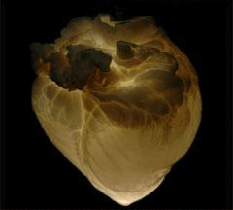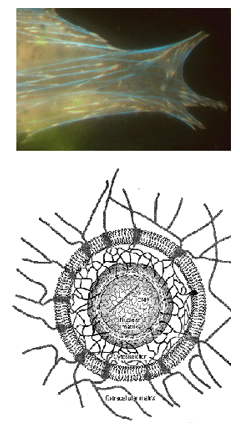By Bernie Clark, October 13th, 2013
We now have scientific proof that our body, at a cellular level, is a Sting fan.
Every breath you take
Every move you make
Every bond you break
Every step you take
I’ll be watching you [1]
Every move we make stresses our body, and our body is made up of trillions of cells. Thanks to the presence of our extracellular matrix [ECM], these cells are all connected together. What we do to the body, we do to our cells, and that is a very good thing because, it turns out, our cells require mechanical stresses, through mechanotransduction, to become activated. To understand how this works and why it is so important for our health and healing, we need to understand a little bit about the ECM.
 The extracellular matrix is what is left in our body when we take away all the living tissues: the muscle cells, blood, organs and skin. What remains is a scaffold of collagen and other fascial fibers that give shape and support to the body. [See the image here of a heart where all the muscle and other cells have been dissolved away, leaving only the ECM.[2] It was long thought that this inert matrix of dead proteins played no role in our healing process, but it turns out that not only is the ECM an incredibly important part of our body, it is absolutely essential for good health. The ECM does much more than give structure or stability: it has many functional roles.
The extracellular matrix is what is left in our body when we take away all the living tissues: the muscle cells, blood, organs and skin. What remains is a scaffold of collagen and other fascial fibers that give shape and support to the body. [See the image here of a heart where all the muscle and other cells have been dissolved away, leaving only the ECM.[2] It was long thought that this inert matrix of dead proteins played no role in our healing process, but it turns out that not only is the ECM an incredibly important part of our body, it is absolutely essential for good health. The ECM does much more than give structure or stability: it has many functional roles.
Just like our body as a whole, every cell has its structure too. Within the cells is a cytoskeleton, made up of the same types of collagen proteins that compose the ECM. The cell’s internal scaffold extends from the DNA within the nucleus out beyond the cellular membrane, and connects with the ECM scaffold. Most of our cells are hard-wired into the whole mechanical continuum of the body. Thus, when we stress our body, we are sending mechanical stress signals to the cells, and via each cell’s own scaffold structure, deep inside the cell as well. The stress of mechanotransduction is one of the major communication pathways that cells use to sense the outside world (along with electrical, chemical and other signaling pathways.)
 In these two images [3] we see, on top, the internal skeleton of a cell, formed of collagen protein (the bluish lines), and below, a graphic depicting how the interior skeleton is continuous with the outer cell integrins, which in turn connect to the ECM. While the ECM is more than just wires, we have also discovered that cells respond to the stress along those wires. If we want to regrow tissues, say cartilage to replace a meniscus that was torn, or a trachea that became so damaged that a patient could not breathe, an artificial scaffold is necessary. This scaffold (sometimes taken from animals or human donors) guides stems to reproduce new cartilage in the right location, but the resulting structure was much weaker than the body’s own, original structure. Something was missing.
In these two images [3] we see, on top, the internal skeleton of a cell, formed of collagen protein (the bluish lines), and below, a graphic depicting how the interior skeleton is continuous with the outer cell integrins, which in turn connect to the ECM. While the ECM is more than just wires, we have also discovered that cells respond to the stress along those wires. If we want to regrow tissues, say cartilage to replace a meniscus that was torn, or a trachea that became so damaged that a patient could not breathe, an artificial scaffold is necessary. This scaffold (sometimes taken from animals or human donors) guides stems to reproduce new cartilage in the right location, but the resulting structure was much weaker than the body’s own, original structure. Something was missing.
There is a mystery in medical science: why do some injuries heal, but not fully. Why do injuries get better for a while, but the job is not finished and some weakness or infirmity remains? The answer to this mystery is starting to be discovered. Stress! The body needs stress in order for our cells to receive communication. Our ECM is under constant tension. The artificial scaffolds used in a laboratory petri dish were under no tension, and thus the stems cells were not getting the proper communication. They didn’t know what to do. When researchers started apply stress to the ECM, the stem cells started behaving in most remarkable ways. They multiplied and migrated to the right places on the scaffold to be most effective. But there was another surprise in store for the researchers: different levels of stress on the matrix caused the stem cells to differentiate into different tissues! One scaffold could initiate stem cell differentiation into a wide variety of different tissue types, because at different locations within the scaffold’s matrix, there were different levels of stress. It is now possible to regenerate a complete organ, with all its complexities of structure, blood vessels and nerves cells through seeding a scaffold with just a few types of stem cells. Researchers have recently grown a complete kidney, which is a very complicated organ, and successfully implanted it into an animal. [4] Human trials are, hopefully, not too far away, and work is proceeding on growing other organs, such as hearts, lungs, livers and even muscles and bone, using the patients own stem cells.
When a stem cell senses flowing movement around it, it will become a blood vessel. If the amount of stress is very slight, it becomes a nerve cell. If the stress is a bit stronger, it becomes a fat cell. Stronger still, the stem cells become a muscle cell. With even more stress, it becomes bone. Too much stress, the stem cells don’t respond at all. Too little or no stress, it likewise remains non-responsive. Stress is needed to stimulate our stem cells to be active, and depending upon the degree of stress, the cells can become the kind of tissue needed for the occasion.
Our extracellular matrix has Velcro-like hooks (called fibronectins) that latch onto cell’s integrins, selecting only the cell type it wants, holding them in place and transferring stresses deep inside the cell where the nucleus can decode the signal and prepare whatever is needed. But the ECM has another trick up its sleeve: it also has growth hormones that stimulate the growth of the new cells.
To quote science writer Bob Holmes, “This may explain why exercise and physical therapy are so important to health and healing – if cells don’t get the right physical cues when you are recovering from an injury, for instance, they won’t know what to do.” [5] And this brings us back to Yin Yoga’s magic ingredient: stress. All tissues need stress to remain healthy. Obviously, we can do too much: if the stresses are too large the cells are not activated. This can be the case when scar tissue has replaced the normal ECM structure. The tissues are too stiff. Cells may also not get the message when the stresses are too slight: instead of muscles, bones or fascia being regenerated, all that is created is fat, which does not help restore strength or range of motion to the injured area. We need to stress our tissues, but we need to do it in the right way and to the right degree. We need to move, to walk, to breath, to stretch, to work on strengthening the muscles and stressing our joints. Sometimes physiotherapy is required to help break through the stiff scar tissue (ouch!), but Yoga can also help. So can a wide variety of exercise modalities, like simply walking, skipping, jumping or dancing – the key to becoming healthy or staying healthy is to move.
When we move, when we breathe, walk, stretch or compress our body, we are sending mechanical signals throughout the matrix. Our trillions of cells are listening; waiting to hear what instructions we are sending. Think of this next time you are marinating in a long-held yoga pose. You are literally turning yourself on, and Sting may be watching you.
Footnotes:
- — Sting’s “Every Breath You Take” is off the album Synchronicity by the Police, released in 1983.
- — The image shown is of a rat’s heart’s collagen scaffold. See Hybrid hearts could solve transplant shortage in New Scientist, June 3, 2009.
- — Image of the actin skeleton of a fibroblast cell from Dr. Christoph Ballestrem. The picture of the cytoskeleton and integrins from Dr. James Oschman.
- — See The matrix: the Secret to Superhealing Regeneration by Andy Coghlan in New Scientist, September 12, 2013
- — See Healing touch: the key to regenerating bodies by Bob Holmes, in New Scientist, February 16, 2010
(Back to Newsletter #17)
